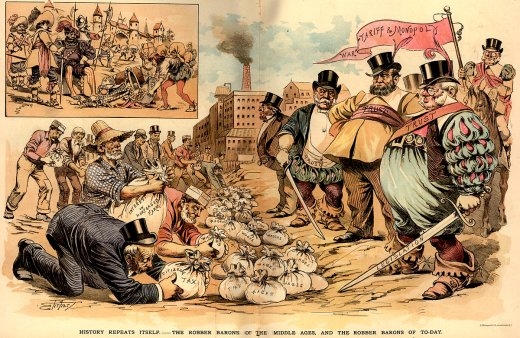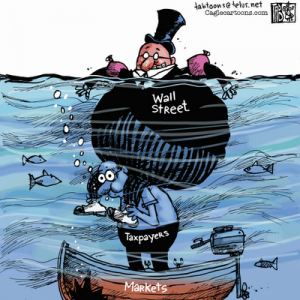
 BY ELLIOT SPITZER FOR SLATE The great irony is that our new place in the global economy is a direct consequence of our grand victory over the past 60 years. We have, indeed, converted virtually the entire world into one integrated capitalist economy, and we must now bear the brunt of serious and vigorous competition. In the immediate aftermath of World War II, the United States was essentially the only nation with financial capital, intellectual capital, skilled labor, a growing middle class generating consumer demand, and a rule of law permitting safe investment. Now we are one of many nations with these critical advantages. This long-term change frames the question we should be asking ourselves: What are we getting for the trillions of dollars in rescue funds? If we are merely extending a fatally flawed status quo, we should invest those dollars elsewhere. Nobody disputes that radical action was needed to forestall total collapse. But we are creating the significant systemic risk not just of rewarding imprudent behavior by private actors but of preventing, through bailouts and subsidies, the process of creative destruction that capitalism depends on.
BY ELLIOT SPITZER FOR SLATE The great irony is that our new place in the global economy is a direct consequence of our grand victory over the past 60 years. We have, indeed, converted virtually the entire world into one integrated capitalist economy, and we must now bear the brunt of serious and vigorous competition. In the immediate aftermath of World War II, the United States was essentially the only nation with financial capital, intellectual capital, skilled labor, a growing middle class generating consumer demand, and a rule of law permitting safe investment. Now we are one of many nations with these critical advantages. This long-term change frames the question we should be asking ourselves: What are we getting for the trillions of dollars in rescue funds? If we are merely extending a fatally flawed status quo, we should invest those dollars elsewhere. Nobody disputes that radical action was needed to forestall total collapse. But we are creating the significant systemic risk not just of rewarding imprudent behavior by private actors but of preventing, through bailouts and subsidies, the process of creative destruction that capitalism depends on.
A more sensible approach would focus not just on rescuing pre-existing financial institutions but, instead, on creating a structure for more contained and competitive ones. For years, we have accepted a theory of financial concentration—not only across all lines of previously differentiated sectors (insurance, commercial banking, investment banking, retail brokerage, etc.) but in terms of sheer size. The theory was that capital depth would permit the various entities, dubbed financial supermarkets, to compete and provide full service to customers while cross-marketing various products. That model has failed. The failure shows in gargantuan losses, bloated overhead, enormous inefficiencies, dramatic and outsized risk taken to generate returns large enough to justify the scale of the organizations, ethical abuses in cross-marketing in violation of fiduciary obligations, and now the need for major taxpayer-financed capital support for virtually every major financial institution. But even more important, from a structural perspective, our dependence on entities of this size ensured that we would fall prey to a “too big to fail” argument in favor of bailouts.
The concentration of power—political as well as economic—that resided in these few institutions has made it  impossible so far for this crisis to be used as an evolutionary step in confronting the true economic issues before us. But imagine if instead of merging more and more banks together, we had broken them apart and forced them to compete in a genuine manner. Or, alternatively, imagine if we had never placed ourselves in a position in which so many institutions were too big to fail. The bailouts might have been unnecessary. In that case, vast sums now being spent on rescue packages might have been available to increase the intellectual capabilities of the next generation, or to support basic research and development that could give us true competitive advantage, or to restructure our bloated health care sector, or to build the type of physical infrastructure we need to be competitive. It is time we permitted the market to work: This means true competition with winners and losers; companies that disappear; shareholders and CEOs who can lose as well as win; and government investment in the long-range competitiveness of our nation, not in a failed business model of financial concentration and failed risk management that holds nobody accountable. MORE
impossible so far for this crisis to be used as an evolutionary step in confronting the true economic issues before us. But imagine if instead of merging more and more banks together, we had broken them apart and forced them to compete in a genuine manner. Or, alternatively, imagine if we had never placed ourselves in a position in which so many institutions were too big to fail. The bailouts might have been unnecessary. In that case, vast sums now being spent on rescue packages might have been available to increase the intellectual capabilities of the next generation, or to support basic research and development that could give us true competitive advantage, or to restructure our bloated health care sector, or to build the type of physical infrastructure we need to be competitive. It is time we permitted the market to work: This means true competition with winners and losers; companies that disappear; shareholders and CEOs who can lose as well as win; and government investment in the long-range competitiveness of our nation, not in a failed business model of financial concentration and failed risk management that holds nobody accountable. MORE
